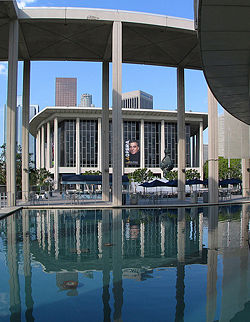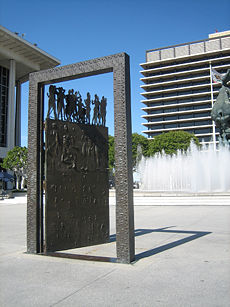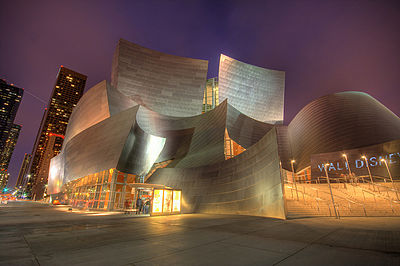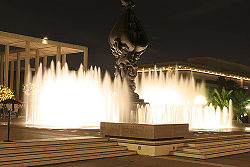Difference between revisions of "Los Angeles Music Center" - New World Encyclopedia
Anne Inoue (talk | contribs) (internal links, notes, references, ext links, ret dates, categories) |
Anne Inoue (talk | contribs) (resize disney) |
||
| Line 39: | Line 39: | ||
==[[Walt Disney Concert Hall]]== | ==[[Walt Disney Concert Hall]]== | ||
| − | [[Image:Disney center night.jpg| | + | [[Image:Disney center night.jpg|400px|left|thumb|The Walt Disney Concert Hall.]] |
On October 23, 2003, the Music Center opened the Frank Gehry-designed Walt Disney Concert Hall, expanding the campus to 11 acres. The 2,265-seat Concert Hall is home to the [[Los Angeles Philharmonic]] and the Los Angeles Master Chorale. Walt Disney Concert Hall includes the 266-seat Roy and Edna Disney/CalArts Theater (REDCAT) and outdoor program areas including the W.M. Keck Foundation Children’s Amphitheatre, seating 250-300, and the Nadine and Ed Carson amphitheater, seating 120.<ref>Frank O. Gehry, Richard Koshalek, D. Borda, et. al. ''Symphony: Frank Gehry's Walt Disney Concert Hall'' (New York: Harry N. Abrams in association with the Los Angeles Philharmonic, 2003, ISBN 9780810991224).</ref> | On October 23, 2003, the Music Center opened the Frank Gehry-designed Walt Disney Concert Hall, expanding the campus to 11 acres. The 2,265-seat Concert Hall is home to the [[Los Angeles Philharmonic]] and the Los Angeles Master Chorale. Walt Disney Concert Hall includes the 266-seat Roy and Edna Disney/CalArts Theater (REDCAT) and outdoor program areas including the W.M. Keck Foundation Children’s Amphitheatre, seating 250-300, and the Nadine and Ed Carson amphitheater, seating 120.<ref>Frank O. Gehry, Richard Koshalek, D. Borda, et. al. ''Symphony: Frank Gehry's Walt Disney Concert Hall'' (New York: Harry N. Abrams in association with the Los Angeles Philharmonic, 2003, ISBN 9780810991224).</ref> | ||
Revision as of 18:22, 17 August 2008
The Performing Arts Center of Los Angeles County, often referred to simply as the Music Center, is one of the three largest performing arts centers in the United States, along with Lincoln Center and the Kennedy Center. Located in downtown Los Angeles, the Music Center is home to the Dorothy Chandler Pavilion, Ahmanson Theater, Mark Taper Forum, and more recently constructed Walt Disney Concert Hall. Each year, the Music Center welcomes more than 2.3 million people to performances by its four internationally renowned performing arts companies: Los Angeles Philharmonic, Center Theatre Group (CTG), L.A. Opera and Los Angeles Master Chorale.
The Music Center's current mission is to go beyond its role as a musical venue and serve as a bridge between cultures. As such, the Music Center's most recent additions (both in programs and structures) have sought to facilitate this, emphasizing cross cultural values and art. For this, the Music Center is renowned in the local Los Angeles area, as well as nationally and internationally. Through its work the center emphasizes the fact that music and art can do much to bring people together in peace.
History
| Performing arts |
|---|
Forms
|
|
Theater · Music · Dance |
Venues
|
|
Palais Garnier · La Scala |
Companies
|
|
Kirov Ballet · American Ballet Theater · New York City Ballet |
In March of 1955, Mrs. Dorothy Chandler began fundraising toward a permanent home for the Los Angeles Philharmonic. Ultimately, Mrs. Chandler raised almost $20 million in private donations; Los Angeles County provided the site and raised the remaining $14 million using mortgage revenue bonds. According to Stephen D. Rountree, President and CEO of the Music Center, "Dorothy Chandler's vision was to create a cultural center that would always remain relevant to the city."[1] To facilitate this, in 1960, Chandler campaigned for additional theaters to be added to the center, convinced that one would not be enough to showcase a rich array of cross cultural genres and performances. She wanted it to house space not only for symphonic music and opera, but also chamber music, traditional theater, and experimental programs.[1] When the Dorothy Chandler Pavilion opened its doors on December 6, 1964, the twenty-eight year old Zubin Mehta led the Los Angeles Philharmonic in a program that featured violinist Jascha Heifetz, performances of Strauss' Fan Fare, and Beethoven's Violin Concerto in D Major.
The rest of the complex was completed in April of 1967.[2] The additional venues, Ahmanson Theatre and the Mark Taper Forum, were dedicated on April 12 and 19, 1967, respectively.[3] Chandler reportedly raised 18.5 million dollars nearly single-handedly[1] The Mark Taper Forum, was famous for "scandalizing the power structure of Los Angeles," according to its artistic director Gordon Davidson, with its provocative opening production of John Whiting's The Devils. The Ahmanson Theatre opened with a performance of the Man of La Mancha by the Civic Light Opera. The first dramatic season at the Ahmanson featured Ingrid Bergman in O'Neill's More Stately Mansions, signaling its intent to marry big-name playwrights with big-name stars.
Over the last thirty-eight years, the Music Center has seen the American debuts of Simon Rattle and Esa-Pekka Salonen, the world premieres of The Shadow Box, Zoot Suit, Children of a Lesser God, and Angels in America at the Taper, and performances by Jessica Tandy, Hume Cronyn, Katharine Hepburn, and Maggie Smith at the Ahmanson. The Philharmonic and L.A. Master Chorale joined forces to provide the accompaniment to Eisenstein's restored silent film classic, Alexander Nevsky. While the Los Angeles Civic Light Opera held its final Music Center Season in 1987, the Los Angeles Music Center Opera was formed in 1986. Productions by the Opear have included Wagner's Tristan and Isolde, directed by Jonathan Miller and designed by David Hockney.
Performing arts venues
The four main venues of the complex (which also includes some smaller theaters and outdoor amphitheaters) are:
- Dorothy Chandler Pavilion: 3,197 seats
- Mark Taper Forum: 745 seats
- Ahmanson Theatre: 1,600 to 2,007 seats, depending on configuration
- Walt Disney Concert Hall: 2,265 seats
Resident companies
The complex has four resident companies:
- Center Theatre Group
- Los Angeles Master Chorale
- Los Angeles Opera
- Los Angeles Philharmonic
Sculptures
The courtyard of the Los Angeles Music Center contains a number of fountains and sculptures for patrons to enjoy before performances and during intermissions.
Peace on Earth
On Sunday afternoon, May 4, 1969, Peace on Earth by Jacques Lipchitz was dedicated. His sculpture portrays a dove descending to earth with the spirit of peace, symbolized by the Madonna standing inside a tear shaped canopy, supported by a base of reclining lambs. Lawrence E. Deutsch and Lloyd Rigler donated $250,000 to commission a work to be placed in the fountains on the Music Center's courtyard. The architects of the Music Center, Welton Becket and Associates, opposed placing sculpture in the plaza between the Dorothy Chandler Pavilion and the Mark Taper Forum. However, after a two year search, the Art Committee of the Music Center prevailed, and commissioned Lipchitz to create the sculpture, now the most photographed work of public art in Los Angles.[4]
The Dance Door
The Dance Door, a bronze sculpture created in 1978 by Robert Graham, and donated to the Music Center in 1982 by Frederick and Marcia Weisman, consists of an ornamented life-size bronze door, hinged on a bronze frame and locked in an open position. The door itself is hollow centered and composed of approximately 7 welded case panels on each side. Abstract figures of dancers are cast in low relief on the door panels.[5]
Walt Disney Concert Hall
On October 23, 2003, the Music Center opened the Frank Gehry-designed Walt Disney Concert Hall, expanding the campus to 11 acres. The 2,265-seat Concert Hall is home to the Los Angeles Philharmonic and the Los Angeles Master Chorale. Walt Disney Concert Hall includes the 266-seat Roy and Edna Disney/CalArts Theater (REDCAT) and outdoor program areas including the W.M. Keck Foundation Children’s Amphitheatre, seating 250-300, and the Nadine and Ed Carson amphitheater, seating 120.[6]
The project began in 1987, when Lillian Disney, widow of Walt Disney, donated $50 million dollars for the concert hall's construction. Los Angeles County provided $110 million to construct a parking garage that would be located underneath the structure. The garage was completed in 1996. The concert hall was completed in 2003, after fundraising stalled during the housing depression of 1994-1996. Upon completion, the entire project was estimated to have cost $274 million.
The acoustics of the concert hall were highly praised upon the Philharmonic's first performance there in fall of 2003. The concert hall is also home to a very large concert organ, built by German organ builder Casper Glatter-Gotz under the tonal direction of Manuel Rosales. The organ was a gift from Toyota Motor Company, out of Japan.
Current governance and administration
The Music Center is governed by a Board of Directors chaired by John Emerson (2003). Center President and Chief Operating Officer is Stephen D. Rountree (2002). The County of Los Angeles owns the Music Center and provides funding for its maintenance, operations, grounds-keeping, security, and ushers. Revenue from the operation of the Center garage offsets these expenses. The Music Center and the four performing arts companies are responsible for the productions presented in the theaters. The Music Center maintains and operates the buildings and the grounds and oversees occupancy of the theaters, restaurant facilities, and the Music Center Archives.
Education
Since its inception in 1979, Music Center and Family Programs has served more than 16 million and currently serves nearly 1 million students and teachers each year. The Music Center believes the arts enhance the lives of all people and are crucial to the development of every child. The Music Center-designed curriculum materials are included in art textbooks published by McGraw Hill in use across the country.
Education and Family Programs events include World City, Pillow Theatre, Performing Books, the Chandler Children’s Festival, the Family Festival, the Very Special Arts Festival, the Spotlight Awards, and the Bravo Awards.
Active arts
Launched in July 2004, and designed to expand the public’s experience associated with the performing arts, Active Arts at the Music Center extends beyond the more formal experience associated with performing arts centers. Active Arts programs engage people from diverse backgrounds and experiences and establishes an ongoing series of admission-free or low-cost recreational art-making events that encourage people to sing, dance, play music, and tell stories together just for the sheer enjoyment and love of the art.
In 2007, the active arts program received a grant of $800,000, distributed over three years. Active Arts programs cut across cultural boundaries and encourage people to participate for the sole purpose of art-making and include Dance Downtown, Drum Downtown, A Taste of Dance, Get Your Chops Back, Friday Night Sing-Along, and Jingle Bell Sing. In essence, the goal of the program is to expand the image of the Music Center, from performing arts center, to civic cultural center, using the arts and public spaces to bridge and build the community.[7]
Dance at the Music Center
Over the past five years, the Music Center has developed an ambitious dance presentation program, which has established a distinguished reputation—locally, nationally, and internationally. The endeavor began in 2000, with the Music Center’s sold-out presentation of the Bolshoi Ballet in its historic production of Prokofiev’s Romeo and Juliet, as well as new interpretation of Don Quixote.
Since then, the Music Center has presented a broad array of ensembles, including New York City Ballet, San Francisco Ballet, American Ballet Theatre, Dance Theatre of Harlem, Alvin Ailey American Dance Theater, Beijing Modern Dance Company, Merce Cunningham Dance Company, Kirov Ballet of the Mariinsky Theatre, Nuevo Ballet Español, Miami City Ballet, and Eifman Ballet of St. Petersburg.
Membership groups
The Music Center has a number of organized membership groups:
- The Blue Ribbon, founded by Mrs. Chandler in 1968, has a membership of more than 625 women who champion the performing arts and make substantial financial contributions to the Center's community programs and its resident companies annually.
- Club 100, founded in 1976, is a group of dynamic professional and civic-minded women who promote the Center's goals through education, advocacy and fundraising. Club 100 sponsors the annual BRAVO Awards, which recognize exemplary arts educators.
- The Fraternity of Friends, founded in 1978, consists of businessmen and entertainment industry leaders who share an interest in the performing arts and the well-being of the Music Center.
- Center Dance Association (CDA) is dedicated to promoting educational programming related to dance, expanding dance audiences in Los Angeles and creating special events related to dance for the enjoyment and further education of its membership.
See also
- John F. Kennedy Center for the Performing Arts
- Lincoln Center for the Performing Arts
- Theater (structure)
Notes
- ↑ 1.0 1.1 1.2 Ryan Jimenez, The Making of a Cultural Icon, Los Angeles Music Center. Retrieved August 16, 2008.
- ↑ William Dudley Hunt, Total Design: Architecture of Welton Becket and Associates (New York: McGraw-Hill Book Company, 1972, ISBN 9780070312982).
- ↑ Teresa Grimes and Tavo Olmos, Historic American Building Survey for the Performing Arts Center of Los Angeles County (Los Angeles, Calif: Music Center, 2002, OCLC: 52428356).
- ↑ Public Art in Los Angeles, Public Art Works in the Los Angeles Civic Center and the Los Angeles Mall Retrieved August 16, 2008.
- ↑ G. Wharton, A Survey of Important Sculptures in Los Angeles County (Sculpture Conservation Studio, Inc).
- ↑ Frank O. Gehry, Richard Koshalek, D. Borda, et. al. Symphony: Frank Gehry's Walt Disney Concert Hall (New York: Harry N. Abrams in association with the Los Angeles Philharmonic, 2003, ISBN 9780810991224).
- ↑ James Irving Foundation, Performing Arts Center of Los Angeles County. Retrieved August 16, 2008.
ReferencesISBN links support NWE through referral fees
- Garrison, Lee C., and Christina Vogl Kaali-Nagy. Comparative profiles of users and nonusers of the Los Angeles Music Center. Los Angeles: Graduate School of Management/Division of Research, University of California, Los Angeles, 1971. OCLC: 26835481
- Gehry, Frank O., and Richard Koshalek. Symphony: Frank Gehry's Walt Disney Concert Hall. New York: Harry N. Abrams in association with the Los Angeles Philharmonic, 2003. ISBN 9780810991224.
- Grimes, Teresa, and Tavo Olmos. Music Center: [Historic American Building Survey for the Performing Arts Center of Los Angeles County. Los Angeles, Calif: Music Center, 2002. OCLC: 52428356.
- Hunt, William Dudley. Total design; architecture of Welton Becket and Associates. New York: McGraw-Hill, 1971. ISBN 9780070312982
- Swed, Mark, and Nancy Zaslavsky. Celebrating twenty five years 1964-1989. Los Angeles: Music Center of Los Angeles County, 1989. OCLC: 25427375.
- Wharton, Gless and Associates. A Survey of Important Sculptures in Los Angeles County. Los Angeles: Sculpture Conservation Studio, Inc., June 25, 1998.
External links
All links retrieved August 16, 2008.
- Music Center Official Website
- L.A. Phil Official Website
- Center Theatre Group Official Website
- L.A. Opera Official Website
- Los Angeles Master Chorale Official Website
- Pictures of the Dance Door
Credits
New World Encyclopedia writers and editors rewrote and completed the Wikipedia article in accordance with New World Encyclopedia standards. This article abides by terms of the Creative Commons CC-by-sa 3.0 License (CC-by-sa), which may be used and disseminated with proper attribution. Credit is due under the terms of this license that can reference both the New World Encyclopedia contributors and the selfless volunteer contributors of the Wikimedia Foundation. To cite this article click here for a list of acceptable citing formats.The history of earlier contributions by wikipedians is accessible to researchers here:
The history of this article since it was imported to New World Encyclopedia:
Note: Some restrictions may apply to use of individual images which are separately licensed.




